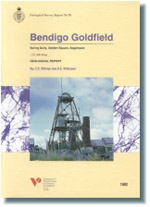GSV Report 93 - Bendigo Goldfield - Spring Gully, Golden Square, Eaglehawk 1:10 000 Maps Geological Report
 |
| |||||||||||||||||||||||||||||||||||||||||||
Product description:Download The downloadable version of this report is supplied in PDF format (16MB). Abstract Mapping of the Bendigo goldfield has resulted in three adjoining 1:10 000 geological sheets which also record the positions of about 5000 shafts and more than 1000 fossil localities. The bedrock of the area is comprised of a Lower Ordovician turbidite sequence which is subdivided into biostratigraphic units based on an excellent graptolite fauna preserved in the mudstones. Mappable lithological units are difficult to define but variations in sediment colour and sand:mud ratio can often be correlated with different biostratigraphic zones. About 1450 m of the sequence is exposed at the present erosional surface. The Ordovician sequence was folded between the Late Silurian and Middle Devonian into a set of NNW-SSE trending tight chevron folds associated with low grade regional metamorphism and strong cleavage development. The regional scale Whitelaw Fault occurs in the north-east part of the map area and numerous small displacement strike faults have resulted from the 'lock-up' of chevron folds. Structural mapping has defined two major structural domains largely based on fold geometry. The Goldfield Structural Domain is characterised by strike persistent and symmetrical folds and the presence of abundant mineralized gold-quartz vein deposits. The Eastern Structural Domain is characterised by asymmetric folds, a west-dipping enveloping surface, phyllitic slates and a strong mineral lineation in some slates. Gold-quartz mineralization occurs as narrow vein style deposits. The siting and geometry of veins is strongly controlled by bedding, folds and faults. Laminated quartz occurs in bedding parallel structures which formed during the early stages of deformation by the 'crack-seal' process. Massive and laminated quartz veins which formed late in deformation, occur within and adjacent to strike faults. Saddle reefs formed at the hinge zones of anticlines and occur as stacked systems on individual folds. Less common 'trough reefs' occur in syncline hinges. Non-metallic resources include clay, sand and gravel. Small abandoned quarries record past extraction of slate and sandstone for paving and building purposes. Late Jurassic lamprophyre dykes intruded anticline hinges and a volcanic breccia of possible Jurassic age occurs in a restricted area. Tertiary fluviatile gravels are preserved on some hills and the present drainage system was initiated in the Early Tertiary. Bibliographic reference Willman, C.E. & Wilkinson, H.E., 1992. Bendigo Goldfield - Spring Gully, Golden Square, Eaglehawk 1:10 000 maps geological report. Geological Survey of Victoria Report 93. Related products:
| ||||||||||||||||||||||||||||||||||||||||||||




